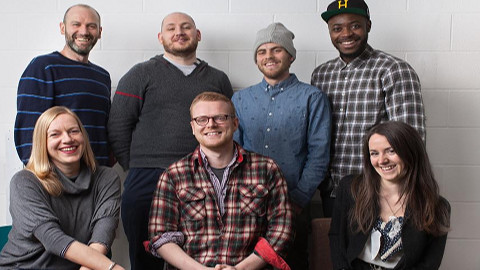Today, Whitechapel is more famous for its arts and creativity than as the home of East End crime and violence. Some however, are still troubled by echoes of its notorious past.
“Jack the Ripper took two of his victims from these streets,” says social entrepreneur Alastair Sloan, brightly. “Since then, if you’re here at night and being honest about what you see around you, not a lot has changed. It breaks my heart, its just a short walk from the Square Mile. Its another world, and its under-reported.”
At the end of 2012, 25-year-old Sloan founded The Living Furniture Project, a social enterprise that trains and employs the homeless to manufacture furniture using reclaimed materials.
He is passionate about its aims: “I found it frustrating that so many people are being left behind in society, despite having such an advanced economy. Social enterprise is a way to deliver welfare in a new way. I’m passionate about it and think its an important tool in trying to fix some of our social problems, especially in times of government austerity and with charity donations falling 30 per cent last year.”
“Social enterprise derives most of it’s income from trading, not grants and donations. That means it could be a more sustainable solution. If in 3 years I still need funding from sponsors or the government, I’ll say I’ve failed. Selling furniture is what will allow us to employ the apprentices, so I have to make beautiful furniture first and foremost.”
Some of London’s best furniture designers, such as Geoff Walker who designed and installed the interior of Shoreditch’s Barrio East, design the furniture. Sloan then manufactures the pieces using reclaimed materials such as timber, metal or discarded furniture scavenged from London’s streets. It may mean hours spent rummaging through skips, but for Sloan it’s worthwhile if it prevents reusable materials from reaching their final resting place – the landfill sites.
“Theres around 10 million pieces of furniture thrown into landfill each year.” He explains: “We’re set to run out of landfill space in the UK in 2018, and over half of that is reusable but still being chucked in the ground. Its not sustainable, and thats why we use 100 percent reclaimed materials.”
The first collection will be released in May, but some pieces are set to be unveiled in the coming weeks. He excitedly shows me designs for an armchair made completely out of old doors, pointing out that whats left over is used to make a table so nothing is wasted.
“One challenge is how repeatable something is. We have to look for interesting things that there are lots of.” He says, picking up a nearby envelope to show the pattern inside. “We’re developing techniques so that we can use these to cover an entire piece of furniture, which will look really cool!” He grins.
“I’m passionate about smart design, but furniture is a fun means to an end. Im trying to create a successful business that allows me to employ people from homeless backgrounds, giving them technical training, confidence and hope for the future.”
“I sit down with them at the beginning and say I’m your employer, your going to work hard and be on time, but I recognise where you’ve come from and if you have any problems I’ll help you with them. In their training they’re paired with a mentor, usually an experienced furniture maker. Its informal, but also personalised. One of my apprentices used to be a gold leafer so we gave him projects around surface finishing and metallic finishing. Now he’s setting himself up as a self employed gold leafer, which is really exciting.”
“We have two apprentices still in training, and two more already being paid. We pay London Living Wage which went up when I was planning the project, testing my resolve a little!” He laughs.
Sloan connects with apprentices through homeless charities Crisis and Providence Row, from whom he’s experienced a little generosity first hand. He admits: “I came to this with a business head on. After university in Edinburgh I started my own business in Shanghai, then came to London to work as a brand manager for a couple of large companies, designing and launching products in the UK and then in ninety countries round the world. All great experiences, but not much of corporate life is relevant to working directly with the homeless. Crisis educated me in the homeless sector, and Providence Row offered me this space to use as my workshop, meaning they’re always on hand next door if we need additional support.”
“Their role is really important. If your homeless, the statistics say your typically going to have a drug problem, an alcohol problem or a mental health problem. The charities are fantastic at fixing those. But then a lot of homeless people hit an invisble glass ceiling that means you can’t get a steady job. That invisible ceiling is basically stigma amongst employers. Thats where The Living Furniture Project comes in. Throwing people back into work after so many years without employment does mean they need the continued support from the charities though.”
“They’re people who’ve had some really tough times and unlucky breaks in life that could happen to anyone. They’ve gone from having a job, family and home to absolutely nothing, thinking ‘where did that come from?!’ Once on the streets life is rough and horrible. Your 13 times more likely to be a victim of violence and your life expectancy plummets to 47, which means thirty years of their life that I, and everyone working in the homeless sector, wants them to have back.”
“We need to rethink what it means to have inequality in this country. Round the corner from here, RBS bankers are walking away with huge bonuses despite delivering a £5bn loss. Apart from commercial incompetence, they also took huge risks which ultimately have massively impacted a lot of people around them. In particular, the welfare of the people I deal with every day. Someone needs to bring those bankers down here and get them to look the homeless people in the eye and say – your housing benefit is being cut, your disability benefit is being cut, but I’m getting paid another hundred thousand this year.”
Still, Sloan remains optimistic: “I hope to see a Living Furniture Project in every country and city.” He says, determined. “We’ve had interest from all over the country to set up similar projects, and even from overseas.”
“Mostly though, I want to challenge peoples perceptions on what homeless people can do. With the right environment and support people can do incredible things, and I’m very excited to prove that!”
www.thelivingfurnitureproject.org.uk






Making furniture out of recycled materials is amazing in itself. People should learn to do these things. It would be a great asset in life.